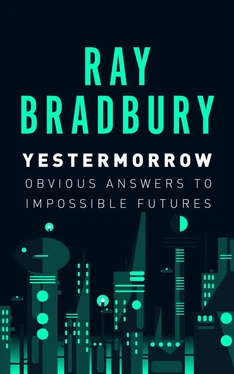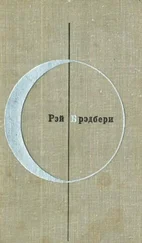Do we fly to far places, then, to get our weathercocks spun north for south, west for east?
We do not set out for that. But that is the secret part and portion of our adventures.
To wander down Piccadilly, turn left, and suddenly say: “Where the hell am I?”
Or to set off in the wrong direction from the Spanish Steps and freeze—wondering which right or left turn to make.
And then the reverse situation—
A week, two weeks, or a month later, figuring the whole damn thing out and suffering what might well be called the Travel Blues. In other words, wanting to be on the move again, to plan again, to know that arriving is okay, but the mysterious journey is the best reason for living. Now, having figured out a town or a city, you are seized by the Desperate Empties.
London as a puzzlement is superb.
London, with its puzzles solved, deflates.
Temporarily, of course. London and Paris are so gigantic it is easy to find new places wherein to vanish and be safe and all in one piece happily reappear. I would not recommend this procedure, this year in New York. Such vanishing might result in a permanent disappearance.
What am I getting at? Why this raving on about environmental inscrutability and the bewildered traveler? Well, most certainly one of the reasons we jet to other lands and other towns is the boredom of the too-familiar at home. We go to Hong Kong and Tokyo not for the reason that we profess, but for the education that leaps upon us unbidden, and the romance that hides around a corner to vanish us for an hour or a day. At the eternally young core of any sojourn is the surprise and delight of being confounded and happily sunk in indecision.
All right, Bradbury, get to it.
The sum?
We have begun to build cities that are too easily solved. There is no mystery, no imaginative lure, no texture in the blank facades, the empty and expressionless faces of banks or other corporate structures. This plus no candy, book, or sweet shops means that when the bank shuts and the IBMers gas on home, the city drops dead. You can skate through those places at 50 miles an hour, for there is nothing to see, nothing to wonder about or linger over. There is no bafflement.
The blind buildings do not even hold out a tin cup, asking for dimes. So, because no texture, no attraction, no chance for you to be enticed into even trying to get lost.
What can we learn from this?
That even in our interior malls, we can plan in such a way that, for a brief if not lengthy time, we can enjoy a few sensations of lostness. To build into these arcades twists and turns, and upper levels that by their mysteriousness draw the eye and attract the soul: That can be the subliminal lure of all future architectures.
Hell, why not, at the very top level of some future mall rear an entire floor labeled: THE ATTIC? Up there stash all your antique shops, antiquarian booksellers, Victorian toy merchants, magic shops, Halloween card and decoration facilities and little cinemas running “Dracula” fourteen hours a day, or name another half-dozen specialty stores that wouldn’t mind being half-lit and fully exciting. Do you mean to tell me that wouldn’t be the first place the kids would rush, hurling themselves and their parents onto escalators headed up among the fireflies and dingbats?
Said Attic to have even more twists, turns, angles, and roundabouts than all six floors below.
Then, when the kids float down with their stunned parents, time to get half-lost on other floors.
To sum yet again: Cities and malls are no fun if your compass is functioning with complete accuracy. The hint of danger without danger. The chance to ascend into expectancy, the chance to descend into satisfaction and delight. To come out of London or Paris, delivering and retrieving yourself from the Lost and Found. To similarly deliver and retrieve yourself from some future New Orleans or Chicago or Denver— Where the Hell am I , Oh Yeah, Now I see! Arcade!
A fascinating future, Yes!?
Where’s my hat? What’s my hurry?
1988
WHO OWNS WHAT AND WHICH AND WHY
A Not So Trivial Pursuit
Who owns the month of July?
Who is the landlord of all October?
Who best paints the Royal Family of Old Spain?
Who is the Proprietor of The Woman through History?
Who created young Manhood for all to witness?
Whose Mary is the Mother of All Mothers in oil or marble?
Who, in sum, owns what and which and why?
And by owning , I mean writing or painting or sculpting or symphonically noting life on earth best. In all the territories of Art, inspired maniacs take over as the centuries pass. They stand tall, each in his own meadow, each in his own castle tower, each wondrously framed on the walls of crammed galleries or in the cool cathedral tombs, daring us to displace them.
Who owns what and which and why?
These are the questions that our Arts pose again and again, to be answered by critics, historians and your plain field-beast observer like myself. It is a grand shuttlecock exchange.
Join me.
Van Gogh owns all the sunflowers that ever sprouted from seed and ran their juices to turn their clock faces to follow noon.
Which means he owns the sun and a portion of summer, which he must share with some few Impressionists.
Valasquez and Goya with or above him, own the Royal Spanish faces; the gimlet eye and the toy-bulldog jaw, the smiling clenched terrier teeth, the crab-claw hands and the razor bones smothered in velvet and spider-draped with lace.
Who has best mapped and blueprinted the touch and temperature of women with palettes like warm seasons and fair breaths?
Botticelli.
But then do I hear a soft cry of “Yes, but—!”
Let us inspect the various aspects of women as revealed by men in a warm season.
The napes of women’s necks? Best painted by—?
Degas? Somewhat.
Renoir? Perhaps.
But most certainly Manet, who sighed on the soft hairs behind their ears, watched them stir, and seized his brushes.
How often Manet genuflects
To the soft sweet napes of women’s necks
While Renoir now our gaze directs
To ladies peach-fuzz frontal sex.
No matter; rear view or facade.
For both I thank a loving God.
Moving on, who has best glorified, gently etched, the Mother of all Mothers?
Da Vinci. His many cartoons and portraits of The Virgin of the Rocks.
More than portraits, these are women and mothers that summon our love temperately and unreservedly.
The sculpted Virgin?
Michelangelo’s Pietà in St. Peter’s.
Who has charted nightmare?
Goya, again, who flew night skies to charcoal witches and land with firing-squads to slay innocents.
Or Bosch’s hell? We visit and revisit it, do we not, with delight?
Why not Callot’s Temptations of St. Anthony ?
The choice is hard.
The social/political/cultural hell is easier.
Hogarth! His surgeon’s scalpel and etching knife pricks the pomps, pox and poisons of London life to drench his plates in acid and trap his grotesques in their terrible pantomimes forever.
Who has created the Eternal Young Man?
Michelangelo. Who knocked David out of the Italian quarries to stand against the sky.
Who owns Dr. Johnson?
Boswell.
Don Quixote?
Cervantes. Yes, but…
Even more, Gustave Dore.
Think of the Mad Don’s windmills. Dore’s etchings rise and stay.
Gargantua and Pantaguel?
Dore.
The Fables of La Fontaine?
Dore.
Others may have written them, but each of these literary works has been taken over, devoured, and delivered back to us by this extraordinary artist/illustrator.
Читать дальше











